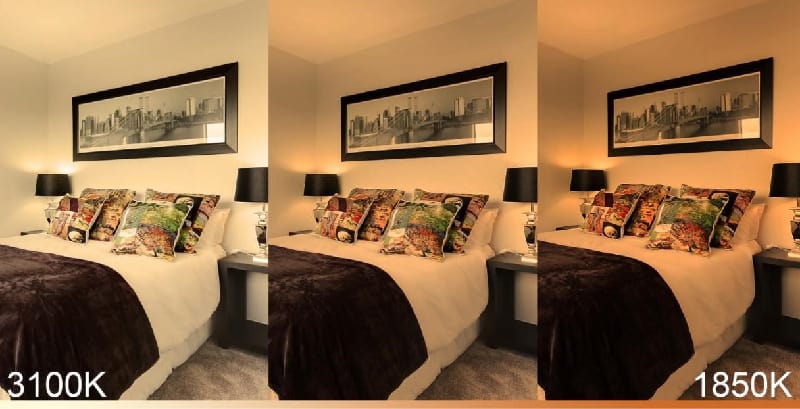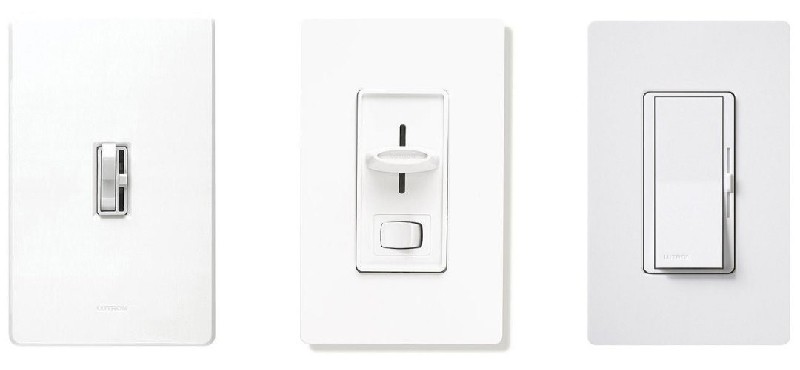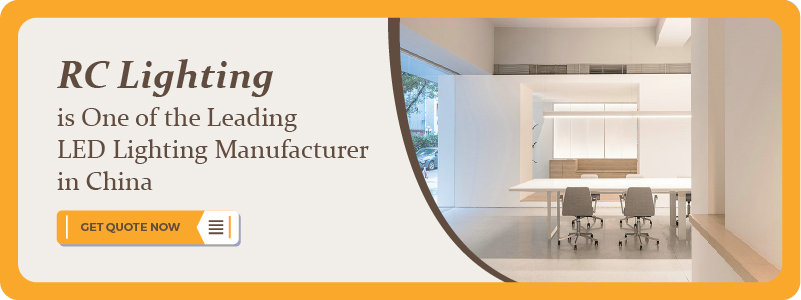Want to know more about it and how it works? Let’s talk about all the little details that make this technology the best in today’s world.
What is Dim to Warm?
Remember the old-school dimming controller for halogen light bulbs? You would do it using the dimmer switch when you wanted to lower the light intensity. This “Dim to Warm” technology is also based on the same principle. Although the brightness of the LED-based lighting fixture could easily be dimmed, there was no way to change the color temperature.
Thanks to the Dim to Warm technology, we can now control color temperature and intensity simultaneously and set the mood according to our desire.
How Does Dim to Warm Work?

This technology allows LED lamps to change their color temperature from 2700K (at 100%) to 1800K (at 0%) as the lighting intensity decreases. They reproduce halogen’s reactive effect and dim to a warmer color temperature.
When a standard LED is dimmed, its intensity decreases while retaining the same color temperature. These LED’s brightness depends on the current supplied; the lower the current, the lower the brightness.
On the other hand, “Dim to Warm” LEDs comprise warm and dim areas. They are equipped with an IC that dims the cool area first and then controls the current supplied to the warm area. Hence, the color temperature of the light gets warm when dimmed.
What Are the Applications of Dim to Warm?
The best thing about this technology is choosing the right color temperature according to the situation and your requirements. Due to the versatility provided by this technology, more and more people are switching to these LEDs and installing them everywhere – such as hotels, restaurants, homes, apartments, etc.
With this amazing technology, you can always have the right light in every condition. For example, you can switch your home office lighting from cool to warm and enjoy a cozy atmosphere. Homeowners love these lights because they can switch from light for dinner to ideal lighting for watching a movie in seconds.
In addition, Dim to Warm lighting is also linked with improving mental and physical well-being. This is because our brains and eyes have evolved to see the world in natural light (sunlight), and our bodies respond to the change in the warmth of light.
Therefore, when we illuminate our homes according to the natural cycle, we can enable our bodies to follow the natural cycle of morning alertness and evening comfort, leading to a better sleep/wake cycle and concentration.
Moreover, it can be used almost everywhere – be it luxury restaurants or the hospitality field.

A Brief Guide to Color Temperature

Most lights equipped with “Dim to Warm” technology range from 2800K to 1800K or 2000K, depending on the manufacturer you opt for.
Approximate color temperatures of various lighting sources:
- 1700K: Match Flame
- 1700K: Low-Pressure Sodium Lamps
- 1850K: Candle Flame, Sunrise/Sunset
- 2100K: High-Pressure Sodium Light Fixture
- 2700K: Tungsten Incandescent Light
- 2900K: Warm White Fluorescent Light
- 3000K: Halogen Light
Did you know that lighting can affect your mood? It does and has a major role in setting our mood. For example, you might have noticed how natural light makes you feel active and sleepy in dim light.
Does the harsh light of the hospitals make you uncomfortable, and restaurants’ soft, warm candle lights make you feel calm? All this is due to the color temperature of the lights.
Various light therapy studies have found that different color temperatures affect moods, circadian rhythms, and heart rates—also, varying intensities of light cause our bodies to release different hormones.
For instance, high color temperature lights (blue or cold lights) trigger the release of serotonin, a hormone that stabilizes our well-being, mood, and happiness. Therefore, opt for lights with short blue wavelengths to feel more energized and make your environment more positive.
On the other hand, low color temperature lights (warm lights) trigger the release of Melatonin, a hormone associated with controlling our sleep and wake cycle. Hence, these lights make us feel more relaxed, comfortable, and sleepy.
Therefore, using the right color temperature lights at the right time of the day can help your body work better. This way, your body can remain active, unwind, and relax when necessary.
Color Temperature Recommendations According to the Space
1. Bedroom
Suggested color temperature: 2700-3000K
For the bedroom, I recommend keeping the lights warm for a soothing atmosphere so you can rest and relax.
2. Bathroom
Suggested color temperature: 2700-4000K
Bathroom spaces are meant to be functional, so installing brighter and cooler lights is your best bet. You can use Dim to Warm lights here if you feel like transforming this space into a more soothing environment.
3. Dining Room
Suggested color temperature: 2700-3000K
You want to strike a perfect balance between warm and cold light in this space. It should be bright enough to see what you eat and comfortable enough to relax after dinner. I recommend installing Dim to Warm lights in this space so you can easily adjust the temperature according to your mood.
4. Kitchen
Suggested color temperature: 2700-4000K
To read the recipes well and cook food without any hindrance, I recommend opting for bright lights in the kitchen. However, installing Dim to Warm lights is an excellent idea if you also eat in the kitchen.
5. Office/Home Office/Workspace
Suggested color temperature: 2700-5000K
Your office is where you have to concentrate and relax when tired. If you use your office primarily during the daytime, 4000K lights will do the job perfectly. However, if your office timings vary between day and night, you can install Warm Dim lights and adjust the temperature according to time and situation.
Types of Light Dimmers

Following are the six most common types of dimmers used to dim different types of lights:
1. Standard/Rotary
This one’s the oldest type of dimmer designed with incandescent lights in mind. When you turn it, the power to the bulb decreases, and hence the light is generated.
2. CL
As the name suggests, this dimmer is made to work smoothly with CFL and LED lamps.
3. Electronic Low Voltage (ELV)
ELV dimmer is designed to be used with an electronic driver. Most Dim to Warm LED fixtures are equipped with this driver.
4. Magnetic Low Voltage (MLV)
These dimmers are designed to work with a magnetic driver.
5. 0-10 Volt
These dimmers are most commonly used in Europe and some commercial applications in the United States. At 0, the light will dim at its minimum intensity, while at 10 volts, the bulb will receive more current from the dimmer, providing its peak brightness.
6. Integrated Dimmers
As the name implies, these dimmers come with built-in LED fixtures, so no additional wiring is required at the user’s end. Lights with integrated dimmers offer their proprietary controls – most commonly, mobile app-based or remote-based.
How to Get Dim to Warm Lighting?
From the kitchen to the kid’s room, small restaurants to luxury hotels, Warm to Dim lights can help create the relaxed setting we all desire. So, how to get it?
You can easily find LED suspensions and lamps equipped with Dim to Warm technology – make sure to look for “Warm Dim” or “Dim to Warm” on the product’s label or description (if shopping online).
If you don’t want to change your lighting design, look for Warm, Dim bulbs and install them in your current fixtures. This is the best and most efficient way to experience this incredible technology.
Conclusion
Unlike standard LEDs, Dim to Warm LED lights allow you to set the mood of your space according to your desire. If you install these Warm Dim lights in your bedroom, you can make them bright when reading a novel or working on your laptop and dim them when you want to relax or sleep.
Whether you need assistance choosing the right LED lights for your place or want a customized lighting design, RC lighting will love to help! So, send us your inquiry today!




